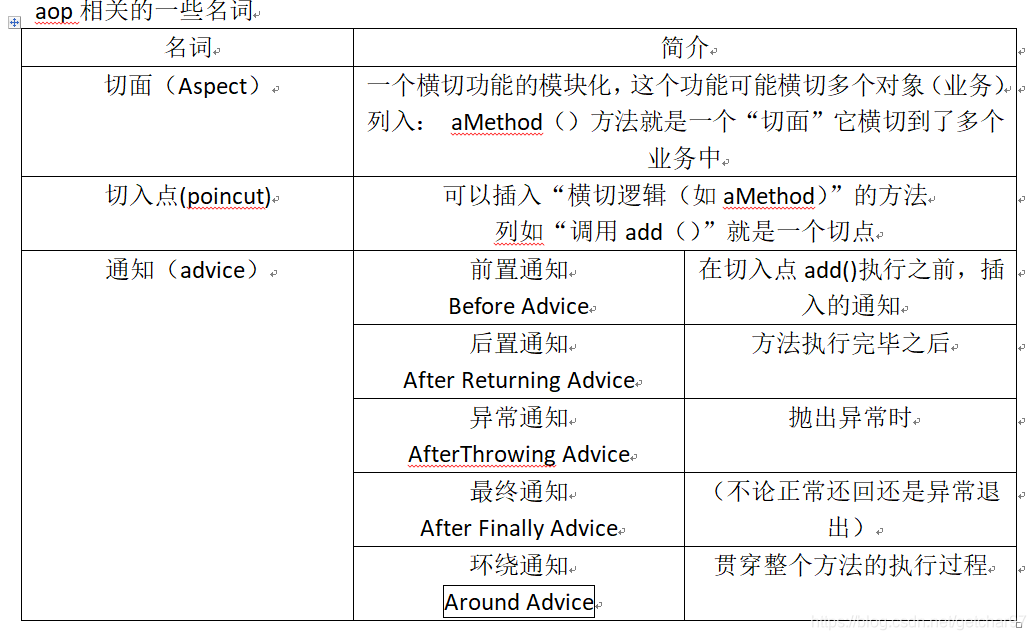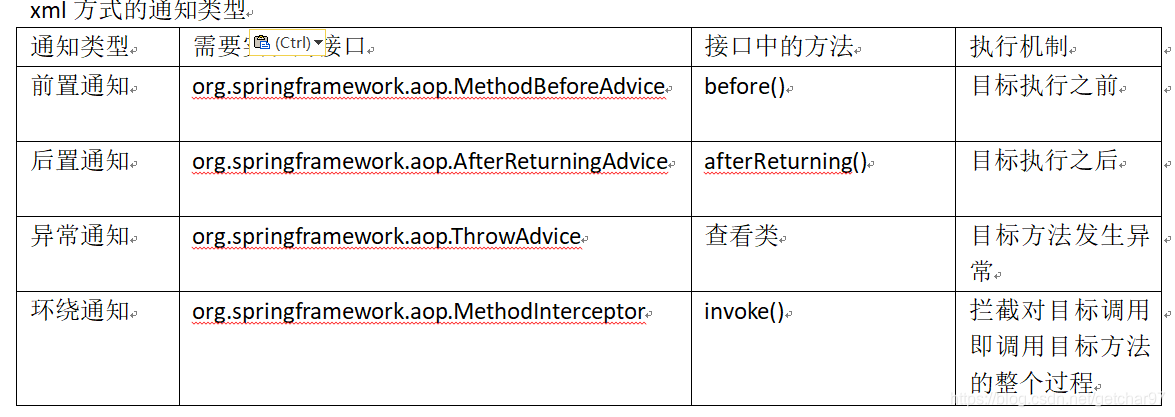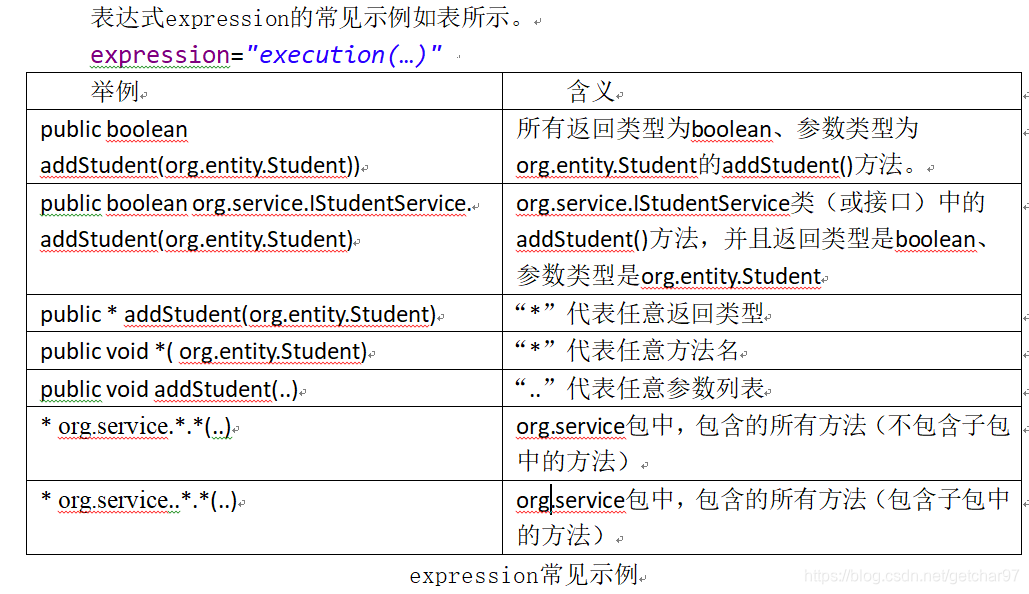AOP:面向方面编程
一个普通的类 -> 有特定功能的类
a.继承类 b.实现接口 c.注解 d.配置

jar:
spring 的基础jar
另需要
spring-aop.jar
aopaliance.jar
aspectjweaver.jar
方式一:实现接口
前置通知: 实现 org.springframework.aop.MethodBeforeAdvice 接口
后置通知:实现 org.springframework.aop.AfterReturningAdvice 接口
异常通知:实现 org.springframework.aop.ThrowsAdvice 接口
参数 :
①都有的参数
Method method, Object[] args, Object target
method :反射包中 ,代表具体的执行方法
args:方法参数列表
target:目标对象
②不同的参数
在后置通知中: 第一个参数 为 Object returnValue 方法的 返回值
在异常通知中:最后一个参数为 需要进行捕获的 《异常类型》
可以实现的方法通过源码可以发现:
public void afterThrowing(Method, args, target, ThrowableSubclass)
public void afterThrowing( ThrowableSubclass)
两个方法任选其一
环绕通知 : 实现 org.aopalliance.intercept.MethodInterceptor 接口
参数:org.aopalliance.intercept.MethodInvocation invocation
环绕通知可实现前面三者 在invocation.proceed()
之前 可以作为前置通知
之后 可以作为后置通知
在catch中 为异常通知
在finally 中 为最终通知


案列: 环绕通知
实现接口
package org.aop;
import org.aopalliance.intercept.MethodInterceptor;
import org.aopalliance.intercept.MethodInvocation;
public class LogAround implements MethodInterceptor{
@Override
public Object invoke(MethodInvocation invocation) throws Throwable {
Object result = null ;
//方法体1...
try {
//方法体2...
System.out.println("用环绕通知实现的[前置通知]...");
// invocation.proceed() 之前的代码:前置通知
result = invocation.proceed() ;//控制着目标方法的执行 ,addStudent()
//result 就是目标方法addStudent()方法的返回值
// invocation.proceed() 之后的代码:后置通知
System.out.println("用环绕通知实现的[后置通知]...:");
System.out.println("目标对象target"+invocation.getThis()+
",调用的方法名:"+invocation.getMethod().getName()+
",方法的参数个数:"+invocation.getArguments().length+",返回值:"+result);
}catch(Exception e) {
//方法体3...
//异常通知
System.out.println("用环绕通知实现的[异常通知]...");
}
return result;//目标方法的返回值
}
}
在applicationContext.xml中配置
<!-- 将准备转为 通知的类 纳入ioc容器 -->
<bean id="logAround " class="org.aop.LogAround "></bean>
<aop:config>
<!-- 切入点(连接线的一端:业务类的具体方法) -->
<aop:pointcut id="around"
expression="execution(public * org.service.impl.StudentServiceImpl.addStudent(..))" />
<!-- (连接线的另一端:通知 类)-->
<aop:advisor advice-ref="logAround " pointcut-ref="around" />
</aop:aspect>
</aop:config>
方式二:基于注解
配置 <aop:aspectj-autoproxy></aop:aspectj-autoproxy> 开启对注解的支持
相关注解
①@Aspect 作用于类
@Aspect 声明该类是一个通知
public class LogforAnnotation(){}
@Aspect 不需要加入扫描器 只需要开启即可 aop:aspectj-autoproxy
②通知的方法注解
前置通知: @Before("execution()") // 切入点
后置通知: @AfterReturning( pointcut= "execution( )" ,returning="returningValue" )
环绕通知: @Around("execution( )")
异常通知: @AfterThrowing(pointcut= "execution ( )",throwing="e")
最终通知: @After("execution( )"
注解形式的返回值:
声明 返回值 的参数名
@AfterReturning(pointcut="excution(public *addStudent(..))",returning = "returnValue"
public void myAfter(JoinPoing jp, Object returnValue){
System.out.println("《注解形式-后置通知》:目标对象:"+jp.getTarget()+
",方法名:"+jp.getSignature().getName() +",参数列表:"+
jp.getArgs().length+",返回值:"+returningValue );
}
环绕通知的参数类型为:ProceedingJoinPoint
注解形式实现 通知的参数不能多 也不能少
实现接口 、注解形式 只能捕获声明的特定类型的异常 而其他异常 不捕获
方式三:基于Scheme配置
>>>>不实现接口 不使用注解 : 通过配置 将类 变成通知
Schema方式实现:
a、编写一个普通的类 public class LogAfter{}
b、将该类 通过配置 转为一个通知
案例
通知方法
package org.aop;
public class LogSchema {
//后置通知方法 :JoinPoint适用于注解
public void afterReturning(JoinPoint jp,Object returnValue) throws Throwable {
System.out.println("》》》》》》》》》》》后置通知:目标对象:"+jp.getThis()+",调用的方法名:"+jp.getSignature().getName()+",方法的参数个数:"+jp.getArgs().length+",方法的返回值:"+returnValue);
}
}
xml配置
<!-- 将准备转为 通知的类 纳入ioc容器 -->
<bean id="logSchema" class="org.aop.LogSchema"></bean>
<aop:config>
<!-- 切入点(连接线的一端:业务类的具体方法) -->
<aop:pointcut expression="execution(public * org.service.impl.StudentServiceImpl.addStudent(..))" id="pcShema"/>
<!-- schema方式 -->
<aop:aspect ref="logSchema">
<!-- 连接线:连接 业务 addStudent 和 通知before -->
<aop:before method="before" pointcut-ref="pcShema"/>
<!-- 连接线:连接 业务 addStudent 和 通知afterReturning -->
<aop:after-returning method="afterReturning" returning="returnValue" pointcut-ref="pcShema"/>
<aop:after-throwing method="whenException" pointcut-ref="pcShema" throwing="e"/>
<!-- 环绕 -->
<aop:around method="around" pointcut-ref="pcShema" />
</aop:aspect>
</aop:config>
可以配置多个通知
总结
如果 要获取目标对象 信息
注解、Schema: JoinPoint
接口 :Method method,Object[] args, Object target
schema 形式 和 注解形式相似 不同之处 注解形式 使用了 注册 @After
schema形式进行 了多余的配置






















 被折叠的 条评论
为什么被折叠?
被折叠的 条评论
为什么被折叠?








